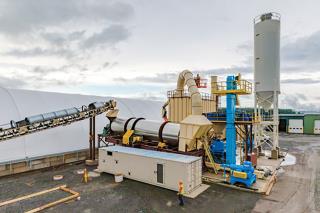The US cement market has been playing catch-up with markets such as Asia where the share of the market held by supplementary cementitious materials (SCM) has grown substantially over the last decade. While factory-produced Portland limestone (Type IL) cement is now rapidly expanding its market share in the US, future innovation is seeking to increase clinker replacement by SCMs even further with the production of a new generation of green cements.
SCMs such as fly ash and slag cement currently dominate the green cement sector. However, calcined clays and recycled concrete are expected to make gains in the coming years as the demand for green cement increases, encouraged by federal and state funding programmes, and new building codes and green building certifications such as LEED and BREEAM, where the environmental performance of building materials support the net-zero ambitions of the cement industry.
Green start-ups are in position
Start-up companies are leading the charge for green cement in the US. Federal and state funding is helping the likes of Sublime Systems, Eco Materials, Hoffmann Green and Brimstone to get established.
Brimstone was awarded the largest sum by the DoE this week of US$189m to fund the construction of its 140,000tpa carbon-free calcium silicate, low-carbon cement which meets the C150 standard.
In the last week, Sublime Systems announced an US$87m funding from the federal government to accelerate the construction of its manufacturing plant in Holyoke, Massachusetts, USA. The funding was announced by the Department of Energy’s Office (DoE) of Clean Energy Demonstrations and is sourced from the Bipartisan Infrastructure Law and Inflation Reduction Act. The current Biden administration is pushing financial support through for projects that support net zero emissions.The Sublime green cement process bypasses the need for extreme heat, unlike the manufacture of OPC that calcines limestone at temperatures up to1450˚C. Sublime’s electrochemical process extracts reactive calcium and silicates from non-carbonate rock at ambient temperature. CO2 emissions can be significantly reduced compared with OPC.
In addition to federal and state interest, traditional cement producers that need to reduce their CO2 emissions, are also expressing an interest in the work of these start-ups. Siam Cement Group is a strategic investor in Sublime Systems and together with the DoE has raised more than US$140m for the start-up. Currently, Sublime Systems operates a 250tpa pilot plant but aims to increase capacity to 45,000tpa at Holyoke in its next phase of development.
In December 2023 Hoffmann Green agreed on the main points of a licensing agreement for several Hoffmann Green production units in the state of Florida. The full contract is due to be signed off this month allowing a US partner company to produce Hoffmann Green's clinker free cement in Florida.
Meanwhile, Eco Materials Inc has ambitions to become the largest producer of green cement in the US. It has plans to double the production capacity of its fly ash harvesting and beneficiation plant in Jewett, Texas, each year and ship 165,000tpa. The product has already been used in projects across Texas, including the Texas Department of Transport’s construction of the I-69 Interchange project in Hidalgo County and the I-35 project in Travis County. Due to their use of green cement these projects reduced carbon emissions by 99 per cent, and produced concrete that Eco Materials claims is 20 per cent stronger and more durable than concrete made with OPC.
Main cement players in the US
The established cement producers are also looking to increase clinker replacement from up to five per cent in OPC to 10-15 per cent in Portland limestone cement (as per US cement standards) and further still with green cement development. Titan America, National Cement and Summit Materials are all in line for US government funding to support their green cement projects.
Titan America LLC has announced that its Roanoke Cement plant has been selected by the DoE to begin negotiations for a US$61.7m award to support a calcined clay production line at the Troutville plant. This project is part of a US$6.3bn Industrial Demonstrations Program, managed by the DoE’s Office of Clean Energy Demonstrations. Meanwhile, National Cement's Lebec plant in California has a US$500m federal cost share in its biomass alternative fuel, calcined clay production and carbon capture project. Summit Materials has also been awarded US$215.6m by federal government for a clay-based cement to replace limestone at multiple sites in the USA.
While the federal subsidies are a boost for the cement sector in the US, analysts at UBS warn that the addition of green cement production may increase overall cement supply in the US and could have an impact on imports.
Global market overview
While green cement production is in its infancy in the US, the global market for green cement was valued at US$620.41m in 2023, according to Precedence Research. By 2033 this market is forecast to grow to around US$1.046bn, at a CAGR of 5.4 per cent from 2024-33. Although Asia had the biggest market share of 34 per cent in 2023, the USA will be the fastest-growing market for green cement as 2033 approaches. The US already accounts for 29 per cent of the green cement market and has overtaken Europe on 24 per cent and Latin America on eight per cent, while the Middle East represents just five per cent of the green cement market, claims Precedence Research.


